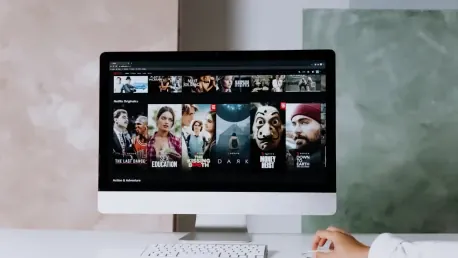There has been a significant shift in Hollywood’s distribution strategies over the past few years, with an increasing focus on direct-to-streaming releases. “Moana 2,” with its enormous $386 million global debut over the Thanksgiving weekend and surpassing $405 million in global earnings, demonstrates the profitability and cultural impact that can be achieved through a traditional theatrical release. This immense box office success of “Moana 2” argues that such triumphs should spell the end of Disney’s, and indeed Hollywood’s, direct-to-streaming blockbuster movie strategy, emphasizing the continued relevance and profits associated with theatrical releases.
Disney initially planned to release the sequel to “Moana” as a Disney+ TV series, aimed at keeping subscribers engaged over multiple weeks with a consistent flow of content instead of a one-time viewing experience. However, the film’s phenomenal box office performance highlights the advantages of a traditional theatrical release. This decision transformed the 2016 animated hit into a significant franchise, ensuring continuity and paving the way for a forthcoming live-action adaptation scheduled for release in 2026, further solidifying the franchise’s legacy and profitability.
The Shift in Hollywood’s Distribution Strategy
The Rise of Streaming Platforms
For a significant period, especially following the onset of the COVID-19 pandemic, major Hollywood studios have attempted to replicate Netflix’s success in the streaming domain. This shift led to the rapid expansion of studio-backed streaming platforms like Disney+, which currently boasts nearly 159 million subscribers globally. Despite this substantial subscriber base, the profitability and sustained cultural relevance of theatrical releases have continued to overshadow direct-to-streaming films, indicating that the latter may not be as advantageous as once believed.
Streaming services offer instant accessibility and the potential for a steady subscription base. However, they often fail to generate the same level of cultural resonance and financial returns as theatrical releases. “Moana 2” would likely not have achieved its massive impact and revenue if it had been released directly on Disney+. Instead of becoming a box office phenomenon that significantly contributes to Disney’s overall revenues, it would have been another addition to the streaming catalog. This might have enticed a few new subscribers but would not have reached the same level of cultural saturation or financial success that a theatrical release can attain.
Cultural Impact and Financial Returns
One crucial point highlighted in the film industry is the considerable difference in cultural impact and financial returns between theatrical and streaming releases. The latter, while convenient and accessible, often fails to evoke the same cultural resonance and financial reward that the former can achieve. “Moana 2” is a prime example; its success in theaters not only demonstrated the potential earnings of a well-handled theatrical release but also underscored the broader cultural conversations it sparked, which would have been unlikely had it debuted on Disney+.
The traditional cinematic experience offers something that streaming platforms cannot replicate: the spectacle and shared experience of watching a film on the big screen. This communal aspect adds to the cultural impact, creating moments that resonate more deeply with audiences. Streaming releases, on the other hand, often get lost in the vast content libraries of platforms. Even with high viewership numbers, they rarely achieve the iconic status or ingrained cultural relevance that theatrical releases do. This discrepancy suggests that while streaming platforms are an essential part of the media landscape, they may not be the best avenue for blockbuster releases aimed at achieving both high financial returns and lasting cultural impact.
The Dilution of Franchises
The Case of “Star Wars” and Marvel
The dilution of major franchises through streaming releases is another concern highlighted within industry circles. Disney’s “Star Wars” series like “The Mandalorian” and Marvel series such as “WandaVision” undoubtedly drew significant viewership to Disney+, enhancing the platform’s appeal. However, this strategy may also have inadvertently diminished the theatrical potential of these franchises. Current Disney CEO Bob Iger has acknowledged this issue, indicating that relying heavily on streaming for big-ticket franchises might not be as financially or culturally advantageous as initially anticipated.
While these series have been beneficial in retaining subscribers and generating buzz, they may also lead to franchise fatigue. By providing more content more frequently, the exclusive allure and anticipation that often accompany theatrical releases are diluted. Fans are accustomed to associating these franchises with a grand cinematic spectacle, and transferring them to a smaller screen, no matter how prestigious, changes audience perceptions. This change is not necessarily negative but may require a rethinking of how to balance streaming content with theatrical releases to preserve the excitement and financial viability of blockbuster franchises.
Long-Term Benefits of Theatrical Releases
The theatrical release of “Moana 2” also exemplifies the crucial long-term benefits associated with this distribution model. After enjoying a profitable run at the box office, the film will continue to generate significant revenue through various channels such as VOD, merchandise sales, Blu-ray releases, and eventually streaming. Its massive theatrical presence will likely enhance its performance on digital platforms as the anticipation and acclaim built during its cinema run will drive additional viewership and purchases in the post-theatrical phase. This multi-channel revenue approach clearly benefits Disney by maximizing their returns without solely relying on subscription-based income.
Additionally, these multiple revenue streams ensure that the initial large production investments yield higher returns over a more extended period. The extensive lifecycle of a theatrically-released film, from cinema to digital platforms, offers broader opportunities for revenue generation. The initial box office success also establishes a robust brand presence, which can be further monetized through various ancillary products and promotions. This layered approach to revenue ensures a higher return on investments compared to the direct-to-streaming model that relies predominantly on subscription fees to offset production costs.
The Resilience of Theatrical Market
The Example of “Encanto”
Moreover, there is a significant trend where even films with less impressive box office performances can achieve substantial success later in their lifecycle. A pertinent example is “Encanto,” which did not fare exceptionally well in theaters but became incredibly popular on Disney+ upon its streaming release. This success story indicates a pattern where theatrical releases can lay the groundwork for subsequent achievements on streaming platforms, creating a synergistic relationship between the two distribution models, rather than an adversarial one.
The case of “Encanto” illuminates how a theatrical release can serve as a valuable promotional tool for a film’s later life on streaming services. The initial buzz and exposure that come with a cinema run can significantly enhance a film’s visibility and reputation. Audiences who might have missed the theatrical release may be more inclined to watch it on a streaming platform, spurred by positive reviews and word-of-mouth generated during its time in theaters. Thus, while the initial box office numbers might not impress, the long-term benefits and extended audience reach through combined theatrical and streaming strategies can be immensely profitable.
The Enduring Appeal of Cinema
In essence, the argument stands that the strategy of releasing blockbuster movies direct-to-streaming is fundamentally flawed within today’s media landscape, where theatrical releases still hold substantial value. The success of “Moana 2” is a testament to the enduring appeal and profitability of the traditional cinematic experience. This suggests that studios like Disney should prioritize projects that can perform well in theaters. Streaming, while an essential part of the viewing ecosystem, should serve as a secondary platform that complements and extends the film’s lifecycle rather than being the primary venue for high-budget blockbusters.
Furthermore, the resilient nature of the theatrical market since the pandemic indicates that audiences still crave the immersive experience that only theaters can provide. The social aspect, combined with state-of-the-art audio-visual presentation, makes theatrical releases unique. This uniqueness is something that the exclusive streaming model cannot replicate. As such, the theater-first strategy not only maximizes revenue across multiple platforms but also enriches the cultural landscape, allowing films to achieve iconic status and engage audiences on a deeper level.
Reevaluating Distribution Strategies
Financial and Cultural Advantages
The ongoing financial and cultural advantages of theatrical releases provide a compelling case for reevaluating current distribution strategies. Continuing to place substantial projects directly onto streaming services, bypassing theaters, has been likened to “setting cash on fire” by industry experts. The theatrical market has demonstrated resilience and recovery since the height of the pandemic, which indicates that there is little justification for studios to favor an exclusive streaming model over a theater-first approach. This insight calls for a strategic pivot, utilizing streaming as a complementary revenue stream rather than the primary release platform.
As Hollywood navigates this reevaluation, it becomes clear that theatrical releases offer more than just immediate box office earnings. They establish a film’s reputation, generate critical acclaim, and create a cultural event that streaming releases struggle to match. This cultural significance translates into long-term financial gains, supporting merchandise sales, special editions, and increased streaming viewership post-theatrical release. With these compounding advantages, the case for prioritizing theatrical releases becomes ever stronger for large-scale projects.
Maximizing Revenue Potential
In recent years, Hollywood has shifted its distribution strategies, increasingly focusing on direct-to-streaming releases. The success of “Moana 2,” which earned $386 million globally over Thanksgiving weekend and surpassed $405 million overall, highlights the profitability and cultural impact of traditional theatrical releases. Such immense box office success indicates that Disney—and Hollywood as a whole—might reconsider their direct-to-streaming blockbuster strategies, underscoring the ongoing relevance and profitability of theatrical releases.
Initially, Disney planned for “Moana 2” to be a Disney+ TV series, intending to engage subscribers with consistent weekly content instead of a single viewing event. However, the film’s exceptional box office performance underscores the benefits of traditional theatrical releases. This choice turned the 2016 hit into a formidable franchise, ensuring its continuity and setting the stage for a forthcoming live-action adaptation in 2026. This approach further cements the franchise’s legacy and demonstrates the financial advantages of big-screen debuts.









